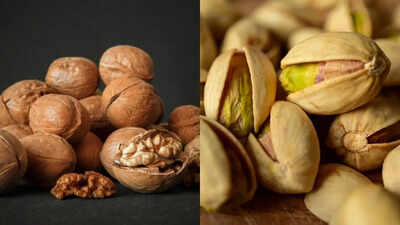Nuts are an excellent snack choice, prized for their delicious taste, satisfying texture, and abundance of nutrients. However, when it comes to optimizing your health, a common question arises: Are walnuts or pistachios the superior option? Both nuts boast a wealth of healthy fats, protein, vitamins, and minerals. Yet, each possesses unique strengths that cater to different nutritional needs.

Both walnuts and pistachios offer a plethora of health benefits, supporting the heart, brain, gut, and overall well-being. While their nutritional profiles overlap, subtle differences in their specific health advantages exist. Understanding these distinctions can empower you to make informed choices about which nut, or perhaps a combination of both, best aligns with your individual dietary objectives.
Here's a breakdown of the key differences between walnuts and pistachios, highlighting their specific benefits:
Pistachios contain a higher amount of protein compared to walnuts.
Protein is essential for muscle building and promoting satiety. If your goal is a snack that keeps you feeling full and energized, pistachios are a more effective choice.
Walnuts stand out as the sole nut source with a substantial quantity of plant-based omega-3 fats, specifically alpha-linolenic acid (ALA).
Omega-3 fatty acids play a crucial role in supporting brain function, enhancing focus, and improving memory. Walnuts are a particularly beneficial choice for students, older adults, and anyone seeking to optimize their cognitive health.
Walnuts are rich in healthy fats that contribute to lower blood pressure and reduce inflammation.
Pistachios excel at lowering “bad” LDL cholesterol levels, thanks to the presence of phytosterols.
Both nuts promote cardiovascular health, making it advantageous to incorporate a variety of each into your regular diet.
Pistachios provide a higher fiber content than walnuts.
Fiber is vital for digestive health, supporting a healthy gut microbiome and aiding in blood sugar regulation. Pistachios may also contribute to the proliferation of beneficial bacteria in the gut.
Pistachios contain lutein and zeaxanthin, two powerful antioxidants that safeguard the eyes and help prevent vision problems, such as macular degeneration. Walnuts contain negligible amounts of these antioxidants.
Incorporating nuts into your daily meals is a simple way to enhance both the flavor and nutritional value of your food. Here are some delicious and practical ideas for enjoying walnuts and pistachios:
Walnuts possess a mild, slightly bitter flavor and a delicate crunch. Their versatility makes them well-suited for both sweet and savory applications.
Pistachios are subtly sweet, vibrantly green, and exceptionally satisfying. The act of shelling them can promote mindful snacking and portion control.
Newer articles
Older articles
 Greg Chappell Hails Rishabh Pant's Revolutionary Impact on Cricket
Greg Chappell Hails Rishabh Pant's Revolutionary Impact on Cricket
 Smith Targets Second Test Return After Baseball Cage Recovery in New York
Smith Targets Second Test Return After Baseball Cage Recovery in New York
 Rishabh Pant's Somersault Celebration Deemed 'Unnecessary' by Doctor Who Oversaw His Recovery From Near-Fatal Crash
Rishabh Pant's Somersault Celebration Deemed 'Unnecessary' by Doctor Who Oversaw His Recovery From Near-Fatal Crash
 Gavaskar Calls for Kuldeep Yadav's Inclusion in 2nd Test Amid Bumrah Fitness Concerns
Gavaskar Calls for Kuldeep Yadav's Inclusion in 2nd Test Amid Bumrah Fitness Concerns
 Rishabh Pant's Composed Reply Dismisses Harry Brook's Sledge in Edgbaston Test: Key Partnership Boosts India
Rishabh Pant's Composed Reply Dismisses Harry Brook's Sledge in Edgbaston Test: Key Partnership Boosts India
 Samsung Unveils Galaxy A35 5G and A55 5G Prices, Availability
Samsung Unveils Galaxy A35 5G and A55 5G Prices, Availability
 Harshit Rana Released: Indian Pacer Exits Squad Before Second England Test in Birmingham
Harshit Rana Released: Indian Pacer Exits Squad Before Second England Test in Birmingham
 Bangladesh Test Captain Najmul Hossain Resigns After Sri Lanka Defeat
Bangladesh Test Captain Najmul Hossain Resigns After Sri Lanka Defeat
 Mirabai Chanu: Weightlifting Demands Constant Mental Focus, Even During Family Time
Mirabai Chanu: Weightlifting Demands Constant Mental Focus, Even During Family Time
 'Manjummel Boys' Star Soubin Shahir Denies Arrest in Film Finance Dispute: Claims of Misleading Accounting Spark Police Probe
'Manjummel Boys' Star Soubin Shahir Denies Arrest in Film Finance Dispute: Claims of Misleading Accounting Spark Police Probe